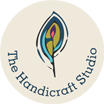The Handicraft Studio's Blog
Hand Embroideries of India
India is a country of diversity; diversity in culture and language, ethnicity and religion, food and climate, dressing style and dance forms and an unparalleled diversity in art and craft. One such craft we love to explore is that of hand embroidery in India.
Did you know there are atleast 20 different types of hand embroideries done in different parts of India? You must be familiar with some like kantha, chikankari, gota patti, zardozi. But then there are more like shamilami, kasuthi, toda, karchobi which are not so commonly known. To add to that, there are variants in each type. For example, Kashmiri embroidery includes kashida and kashmiri stitches with sub variants called naala jaal and neem jaal. Kantha has several types like lep kantha, sujani kantha, durjani kantha, baiton kantha, oaar kantha, archilata kantha and rumal kantha.
Count all the basic types and their variants and sub-variants and we may be looking at close to a hundred types of hand-embroidery styles in India…talk about diversity!
If we could have even one piece of each of these types, what a treasure trove of culture and heritage our wardrobes would be!
You could shop this “diversity” from our collection of hand embroidered dupattas on our website www.thehandicraftstudio.com while we give you a very brief overview of the crafts available with us.
Phulkari
(Phul – flower, Kari – work) Phulkari is the most famous hand embroidery style in Punjab. Mentioned first in the traditional love story of Heer-Ranjha, and dating back to the 15th century, phulkari literally means ‘a garden of flowers’ and is the traditional form of embroidery that has been handed down several generations. It was mainly done on khadi cloth, using bright coloured threads, but is now done on all types of fabric including georgettes, chiffons, cottons and synthetic fabrics. The darn stitch done on the wrong side of the fabric leaves a long stitch in front, that forms a pattern of flowers.
Phulkari, like most other types of hand-embroidery has three main variants – Bagh, Chobe and Shashidar. Bagh is the most commonly used form which involves an all-over pattern of geometric flowers. In Chobe, only the border of the fabric is embroidered, while the rest of it is kept plain. Shashidar phulkari involves working tiny mirrors into the embroidery.

Chikankari
Chikankari is associated with Uttar Pradesh, and more specifically with Lucknow. However, there are many different stories woven around the origin of this craft. Some people believe the work originated in East Bengal, while others have recorded that the Mughal Emperor Jehangir’s wife, Noor Jahan, introduced this Persian art. There is also a story that describes a traveller who taught the art form to a peasant in return for water. We don’t know which of these is the factual origin of Chikankari, but we do know that it was practiced and perfected mainly in Lucknow and Awadh during and after the Mughal Empire.
Chikankari was traditionally delicate, white, floral embroidery on white muslin or mul cloth. Gradually, more colours were introduced as were different fabric types like silk, organza, chiffon and georgette. Chikankari is mostly done using chain stitch, back stitch, herringbone stitch and satin stitch.
Inspite of all the colours you find with chikan work these days, the traditional white-on-white piece remains ethereally beautiful and is an essential part of any woman’s (or for that matter man’s) wardrobe.

Kantha
Kantha, a popular and probably one of the oldest forms of Indian embroidery, originated in West Bengal and, over time, spread across Odisha and Bangladesh as well. The word ‘kantha’ means ‘rags’ in Sanskrit. Traditionally, kantha was used to make quilts by rural women. Sarees and old dhotis were piled on top of each other and a simple running stitch was used to stitch them together, to make soft quilts, blankets and shawls. The basic goal was to reuse and recycle as much as possible, while providing soft, comfortable warmth mostly to babies and older people. For centuries, this craft was passed down from mother to daughter and slowly, women started embroidering their own clothes with this craft. Sarees, handkerchiefs and dhotis, were all embroidered with kantha work along the border.
The types of kantha work are based on the ultimate use of the product on which kantha is embroidered. Just to name a few…Lep kantha is used to for quilts, Sujani kantha is used for bedspreads, Baiton kantha is used to wrap books and precious objects.
The craft came into mainstream fashion in the 1980s when it started getting noticed for its vibrancy of colour, exclusiveness of design and simple yet graceful beauty. It is now embroidered on sarees, suits, dupattas in cotton and silk and is widely used by top fashion designers of the country. This is one form of embroidery that has moved from ‘rags to riches’ in the literal sense!


